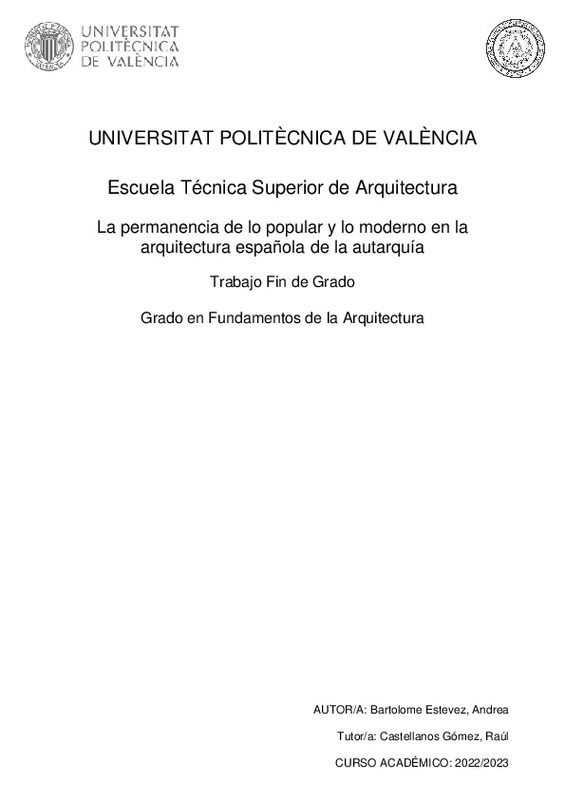JavaScript is disabled for your browser. Some features of this site may not work without it.
Buscar en RiuNet
Listar
Mi cuenta
Estadísticas
Ayuda RiuNet
Admin. UPV
La permanencia de lo popular y lo moderno en la arquitectura española de la autarquía
Mostrar el registro sencillo del ítem
Ficheros en el ítem
| dc.contributor.advisor | Castellanos Gómez, Raúl
|
es_ES |
| dc.contributor.author | Bartolomé Estévez, Andrea
|
es_ES |
| dc.date.accessioned | 2023-12-20T11:30:09Z | |
| dc.date.available | 2023-12-20T11:30:09Z | |
| dc.date.created | 2023-09-29 | |
| dc.date.issued | 2023-12-20 | es_ES |
| dc.identifier.uri | http://hdl.handle.net/10251/200963 | |
| dc.description.abstract | [EN] The search and recovery of the popular is a recurring phenomenon in the history of architecture. However, the emergence of modernity seemed to completely deny this principle. In Spain, during the period of autarky, a new generation of architects would face this historical conflict first-hand: how to reconcile the survival of the popular - as rooted in culture as it is officially imposed - with the adventure towards the modern that would not take long to blossom. This research tries to follow a common thread through this problem of Spanish architecture between the 1940s and 1950s. It is through the works that this discourse is articulated over time, being the ones who truly show us the intentions of their authors and the paradoxes of the time. The works are collected and ordered as evidence distributed throughout the Spanish territory, and it is particularly studied what happens behind the focusses of Madrid and Barcelona, articulating a parallel discourse to the already known, more in the north of Spain, with works that turned out to be milestones for the places where they were conceived but were eclipsed by the bifocality of Spanish architecture. This look at the study period, apparently contradictory given the multiplicity of styles that follow one another in it, would come to show that, after the apparent differences, more essential and permanent attributes lie behind. Concrete architectures serve, therefore, to qualify the absolute truths embodied in the great stories, and reveal, perhaps, the permanence of the popular in the modern in the Spanish architecture of the first Franco regime. | es_ES |
| dc.description.abstract | [ES] La búsqueda y recuperación de lo popular es un fenómeno recurrente en la historia de la arquitectura. No obstante, la irrupción de la modernidad pareció negar completamente este principio. En España, durante el período de la autarquía, una nueva generación de arquitectos se enfrentaría de primera mano a este conflicto histórico: cómo conciliar la pervivencia de lo popular —tan arraigada en la cultura como impuesta oficialmente— con la aventura hacia lo moderno que no tardaría en eclosionar. Esta investigación trata de seguir un hilo conductor a través de esta problemática de la arquitectura española entre los años cuarenta y cincuenta. Es a través de las obras como se articula este discurso a lo largo del tiempo, siendo ellas quienes nos muestran verdaderamente las intenciones de sus autores y las paradojas de la época. Las obras se recogen y ordenan como evidencias repartidas por el territorio español, y se estudia particularmente qué ocurre tras los focos de Madrid y Barcelona, articulando un discurso paralelo al ya conocido, más en el norte de España, con obras que resultaron ser hitos para los lugares donde fueron concebidas pero quedaron eclipsadas por la bifocalidad de la arquitectura española. Esta mirada sobre el período de estudio, aparentemente contradictorio dada la multiplicidad de estilos que en él se suceden, vendría a demostrar que, tras las aparentes diferencias, subyacen atributos más esenciales y permanentes. Sirvan, pues, las arquitecturas concretas para matizar las verdades absolutas plasmadas en los grandes relatos, y revelar, tal vez, la permanencia de lo popular en lo moderno en la arquitectura española del primer franquismo | es_ES |
| dc.format.extent | 87 | es_ES |
| dc.language | Español | es_ES |
| dc.publisher | Universitat Politècnica de València | es_ES |
| dc.rights | Reserva de todos los derechos | es_ES |
| dc.subject | Arquitectura española | es_ES |
| dc.subject | Arquitectura popular | es_ES |
| dc.subject | Movimiento moderno | es_ES |
| dc.subject | Primer franquismo | es_ES |
| dc.subject | Norte de España | es_ES |
| dc.subject | Spanish architecture | es_ES |
| dc.subject | Popular architecture | es_ES |
| dc.subject | Modern movement | es_ES |
| dc.subject | First Francoism | es_ES |
| dc.subject | Northern Spain | es_ES |
| dc.subject.classification | PROYECTOS ARQUITECTONICOS | es_ES |
| dc.subject.other | Grado en Fundamentos de la Arquitectura-Grau en Fonaments de l'Arquitectura | es_ES |
| dc.title | La permanencia de lo popular y lo moderno en la arquitectura española de la autarquía | es_ES |
| dc.title.alternative | The permanence of the popular and the modern in the Spanish architecture of the autarky | es_ES |
| dc.title.alternative | La permanència del popular i el modern en l'arquitectura espanyola de l'autarquia | es_ES |
| dc.type | Proyecto/Trabajo fin de carrera/grado | es_ES |
| dc.rights.accessRights | Abierto | es_ES |
| dc.contributor.affiliation | Universitat Politècnica de València. Departamento de Proyectos Arquitectónicos - Departament de Projectes Arquitectònics | es_ES |
| dc.contributor.affiliation | Universitat Politècnica de València. Escuela Técnica Superior de Arquitectura - Escola Tècnica Superior d'Arquitectura | es_ES |
| dc.description.bibliographicCitation | Bartolomé Estévez, A. (2023). La permanencia de lo popular y lo moderno en la arquitectura española de la autarquía. Universitat Politècnica de València. http://hdl.handle.net/10251/200963 | es_ES |
| dc.description.accrualMethod | TFGM | es_ES |
| dc.relation.pasarela | TFGM\158991 | es_ES |
Este ítem aparece en la(s) siguiente(s) colección(ones)
-
ETSA - Trabajos académicos [4687]
Escuela Técnica Superior de Arquitectura






